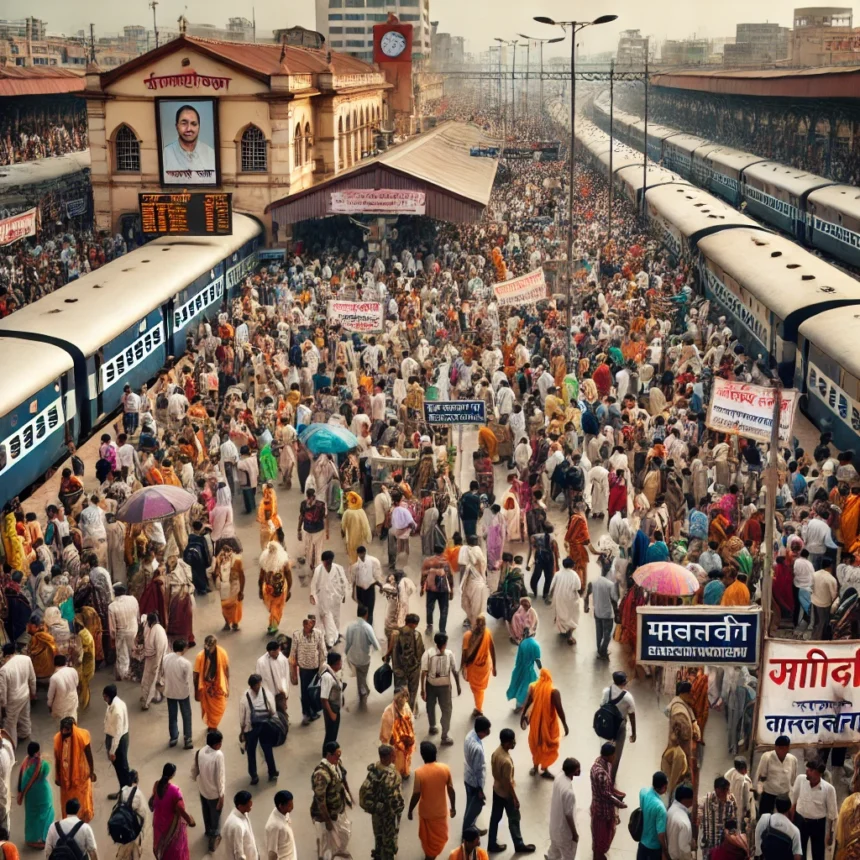Maha Kumbh Mela 2025 and Railway Stations Chaos
Analyzing Railway Problems During Maha Kumbh Mela
The Maha Kumbh Mela in Prayagraj, held every 12 years, is one of the largest religious gatherings in the world, drawing millions of devotees to the confluence of the Ganga, Yamuna, and the mythical Saraswati at Sangam. This year, the event has not only put Prayagraj’s infrastructure to the test but has also significantly impacted railway operations across India, with stations far from Prayagraj facing their share of challenges due to the massive influx of pilgrims.
Background
In my ongoing series on the Maha Kumbh Mela, understanding its historical and cultural context is key. Held every 12 years in Prayagraj, this event is one of Hindu’s most sacred pilgrimages, tracing back millennia. It celebrates the mythological churning of the ocean of milk, where drops of immortality fell at Prayagraj’s Sangam, the confluence of the Ganga, Yamuna, and mythical Saraswati rivers.
The Maha Kumbh Mela attracts millions, showcasing India’s spiritual diversity with sadhus, ascetics, and devotees participating in rituals and seeking purification through the holy dip. Culturally, it’s a rich festival blending spirituality with tradition, historically documented in ancient texts like the Mahabharata. This backdrop helps explain the challenges and motivations behind the railway incidents during the Maha Kumbh Mela 2025.
New Delhi Railway Station: A Tragic Incident
Video showing the Chaos at New Delhi Railway Station just before the stampede
One of the most harrowing incidents occurred at New Delhi Railway Station, where a stampede led to the tragic loss of 18 lives. The incident unfolded when a mix-up in train announcements caused confusion among passengers, leading to a rush towards platform 16.
Eyewitness Insights: “It was chaos everywhere. People were running to catch their trains, and in no time, it turned into a stampede,” recalls Mr. Sharma, a pilgrim who witnessed the stampede at New Delhi Railway Station.
Official Statements: “Our immediate response was to dispatch additional forces to manage the crowd and ensure safety at all costs,” explains a senior officer from the Railway Protection Force (RPF).
This event underscored the need for better crowd management and clearer communication at major transit hubs during large-scale events. In response, security was tightened with the deployment of additional personnel from the Delhi Police, Railway Protection Force (RPF), and Government Railway Police (GRP). Enhanced measures like barricades, intensified patrolling, and real-time CCTV monitoring were implemented to prevent further incidents.
Madhubani Station: Vandalism and Frustration
The fervor to reach Prayagraj led to a notable incident at Madhubani Railway Station in Bihar. Devotees, frustrated by their inability to board an already overcrowded train, resorted to vandalism. The Swatantrata Senani Express was attacked with stones, resulting in broken windows and a chaotic scene. This act of desperation underlines the intense desire of pilgrims to participate in the Maha Kumbh Mela and the overwhelming pressure on railway infrastructure during such events. The incident raised alarms about crowd control and the safety of passengers, prompting immediate security measures and discussions on crowd management strategies.
General Chaos in Bihar’s Stations
Across Bihar, stations like Patna, Danapur, Ara, Gaya, Sasaram, Muzaffarpur, Sitamarhi, and Darbhanga have witnessed an unprecedented rush of passengers. The East Central Railway (ECR) has responded by strictly enforcing rules against entering stations without valid tickets to manage the crowd. This measure was partly in response to the tragic stampede at New Delhi Railway Station, ensuring that Bihar’s stations do not face similar fates. Additional ticket counters, enhanced security presence, and coordination with local district administration have been part of the response to manage the influx of devotees heading to Maha Kumbh Mela.
Traffic and Crowd Management Beyond Prayagraj
The ripple effect of the Maha Kumbh Mela was felt in stations like Lucknow’s Charbagh, Kanpur Central, and Varanasi, where authorities took proactive steps to manage the expected surge in passenger numbers. In Lucknow, security reviews were conducted to ensure adequate facilities were in place to handle the crowd. Kanpur saw directives for stronger safety protocols, particularly around platform changes, while Varanasi, being relatively close to Prayagraj, had to deal with increased passenger traffic, leading to additional precautions to avoid overcrowding.
The Broader Impact on Rail Services
The sheer volume of pilgrims has necessitated the operation of approximately 13,000 trains, including 3,000 special ones, to connect major cities to Prayagraj. This has led to a significant strain on railway stations across the country. Stations like those in Ayodhya, Mirzapur, and even further afield have had to adapt to the increased load, with some stations creating holding areas for passengers and implementing strict entry and exit protocols to manage crowds effectively.
Lessons Learned and Looking Forward
The incidents at railway stations outside Prayagraj during the Maha Kumbh Mela have shed light on several key areas for future improvement:
Communication: The importance of clear, accurate, and timely announcements cannot be overstated. Miscommunication led to confusion and chaos, emphasizing the need for effective systems to relay information to passengers.
Crowd Management: Better strategies are essential, particularly around entry and exit points and during peak hours. Stations must be equipped with plans to manage large crowds effectively, reducing the risk of stampedes or overcrowding.
Infrastructure: The current infrastructure showed its limitations in handling such massive gatherings. Upgrades are necessary, with temporary solutions like additional ticket counters, shelters, and medical assistance points proving beneficial but not sufficient for long-term needs.
Safety Measures: The events underscored the need for enhanced security and rapid response capabilities to manage emergencies. This includes not just physical measures but also training for railway staff in crisis management.
These insights are pivotal for enhancing the management of not only the ongoing Maha Kumbh Mela but also for planning and executing future large-scale events across India. The coordination between railway authorities, local police, and other security forces has been put to the test, offering valuable lessons for future preparedness.
Root Cause Analysis and Recommendations
The incidents at railway stations far from Prayagraj during the Maha Kumbh Mela indicate:
- Localized Focus: Preparations like sensitizing staff and establishing SOPs were concentrated in Prayagraj, leaving other stations less prepared.
- Communication Gaps: Information about train schedules and crowd control was not effectively communicated nationwide.
- Resource Allocation: Resources were heavily focused on Prayagraj, leaving other stations under-equipped to handle the crowd surge.
- Training Disparity: Railway staff outside Prayagraj might not have received adequate training for managing large crowds during such events.
- Policy Implementation: While policies existed for Prayagraj, their application across the country was inconsistent.
Recommendations:
- National SOPs: Create uniform procedures for all stations during mass gatherings.
- Wider Training: Educate staff across India on managing crowds and emergencies.
- Resource Planning: Better distribute resources anticipating crowd flow across the network.
- Enhanced Communication: Improve information sharing across all stations.
Safety and Management Initiatives
- Ticket Restrictions: Only ticket holders allowed entry to prevent overcrowding.
- Security Measures: Increased collaboration with local forces for crowd monitoring.
- Communication: Focus on clearer, timely information to avoid confusion.
Lessons and Future Readiness
From Bihar’s experience:
- Infrastructure and Planning: Need for enhanced facilities and crowd dispersal systems.
- Emergency Preparedness: Requirement for comprehensive emergency response plans.
- Public Awareness: Importance of educating travelers about peak-time travel.
These insights underscore the need for national coordination to transform the fervor of religious gatherings into well-managed, safe pilgrimages.
Reflections on Railway Problems during Maha Kumbh Mela
The incidents at railway stations far from Prayagraj during the Maha Kumbh Mela 2025 reveal a complex interplay of cultural fervor, logistical challenges, and administrative responses. While considerable efforts were made to manage the influx of pilgrims, the events underscore the necessity for a holistic approach to crowd management, communication, and infrastructure development across India’s railway network.
As we move forward, the investigation into these occurrences will continue in my series, aiming to shed more light on how such massive gatherings can be better prepared for in the future. We will explore further the cultural significance, the psychological motivations behind the rush, and the practical lessons learned, ensuring that the spiritual journey of millions can be both safe and spiritually fulfilling. Stay tuned for more insights as this saga unfolds, highlighting both the resilience and the areas of improvement within India’s approach to managing one of the world’s largest religious congregations.
Feature Image: Click here to view the image.
Visit our Youtube Channel by clicking here.
Click here to visit the related page on Medium.com
Follow us on our social median handles
Glossary of Terms:
- SOPs (Standard Operating Procedures): Predefined protocols that outline the steps to be taken in specific situations, ensuring consistency and efficiency in operations.
- ECR (East Central Railway): One of the 19 railway zones in India, responsible for managing railway operations in the eastern and central regions.
- RPF (Railway Protection Force): A security force responsible for protecting railway property, passengers, and staff.
- GRP (Government Railway Police): A police force responsible for maintaining law and order on railway property.
- Crowd Management: Strategies and techniques used to manage large crowds, ensuring safety and order.
- Emergency Response Plan: A plan outlining the procedures to be followed in case of an emergency, ensuring timely and effective response.
- Crowd Control Measures: Strategies and techniques used to manage and direct crowds, preventing overcrowding and ensuring safety.
- Mahakumbh Mela: A massive Hindu pilgrimage that takes place every 12 years, attracting millions of devotees.
- Sangam: The confluence of the Ganga, Yamuna, and mythical Saraswati rivers in Prayagraj.
- Ganga: A sacred river in Hinduism, considered one of the most holy rivers in India.
- Yamuna: A sacred river in Hinduism, considered one of the most holy rivers in India.
Saraswati: A mythical river in Hindu mythology, believed to be invisible and existing only in the spiritual realm.
Top Hashtags: #festivals #india #bhfyp #festival #railways #Mahakumbh #Mahakumbhmela



Leave a Reply